I’ve already talked about what you need to know before you adopt a bunny. Now it’s time to talk about what you need to do to care for your bunny once you have it in your home. You now know what to feed Bunny, what not to feed Bunny and how to keep Bunny entertained. Now it’s time to talk about socializing, introducing Bunny to other pets and litter training Bunny. Let’s get started.
Socializing Your New Bunny
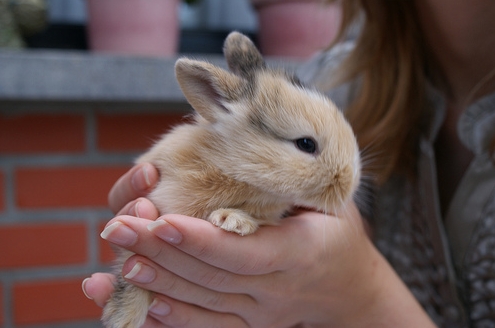
Q: How do I socialize my bunny?
A: Let the bunny get used to your family. Put the bunny’s cage in a room where it will be around the family and get used to seeing your family members and get used to everyone’s voice. Most importantly, be patient and start socializing your bunny from an early age. The older the bunny is, the harder the process will be.
Let the bunny come to you or your kids when it is out of its cage. Make sure your kids know that chasing Bunny is not okay. If you let your kids chase the bunny around, it will learn to fear them which will not help the socializing process at all. The more you let the bunny out around your kids, the more curious about your kids the bunny will get. It will approach them timidly so avoid fast or aggressive movements.
Once Bunny has started approaching the kids, you can start allowing the kids to give the bunny a little treat. This helps Bunny associate the child with something positive. After a few treats are given, your child can begin brushing Bunny and eventually, picking Bunny up.
Most importantly, don’t rush the process. Let Bunny move at its own pace and try to encourage your kids to be patient as well. If your kids get frustrated, the process will be much slower. Help them understand that Bunny needs time to get used to people. That might be the hardest part of the process but the benefit will be well worth it.
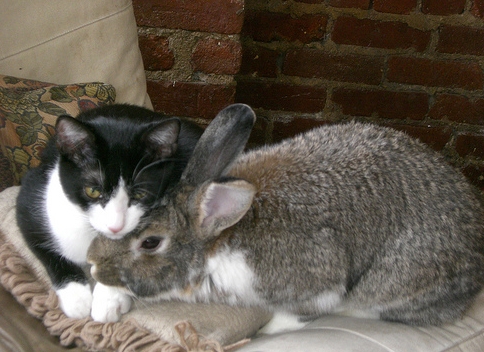
Q: What is the best way to introduce my bunny to my cat or dog?
A: Several things go into a safe introduction. First and foremost, you need a good introduction cage for your rabbit. It must have a place for Bunny to hide in should it get scared. This is why my rabbit’s cage as the little wooden house (which also doubles as a great chew toy). Rabbits get frightened easily. You need to do everything you can do to make sure your new friend feels secure.
Ensure that your introduction cage is large enough that your rabbit can run around. This allows your cat or dog to get used to the sight of the Bunny running. This is especially important with cats. The more your cat sees the Bunny running, the more familiar it will get with those impulses to chase and hunt and the better it will get at controlling those impulses. Giving the rabbit room to run around in its introduction cage will also make the process much more comfortable for the Bunny.
Beyond that, it’s all about patience. The introduction process can take several days or even a week or more depending on how everyone adjusts. You don’t have to watch the animals constantly. Move the introduction cage into the living room and watch television while the animals get acquainted. Just make sure you don’t leave them completely unattended.
You can let the Bunny out of the introduction cage once your other pets have gotten used to the Bunny running around. Watch how your pets (again, cats especially) react when the Bunny is running back and forth in its cage. If the cat doesn’t pay much attention at all, it’s time to let Bunny out. Never leave the Bunny and your other pets unattended for the first few weeks. Once out of the cage your dog may want to sniff (or in Deniro’s case, at least, lick and groom) the Bunny. This is fine. Your Bunny will let the animal know when it’s had enough. Just be sure you’re present, alert and ready to handle any bad behavior.
Litter Training Your New Bunny
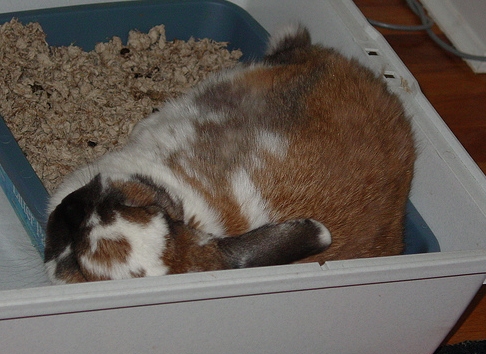
Q: What kind of litter pan should I buy for my bunny?
A: Litter training a bunny isn’t really all that difficult. It just takes a little time and patience and the willingness to accept a few accidents in the meantime. To start, you need to choose the right litter pan for your bunny. The pan needs to be easy for your bunny to easily get into and out of. It should also be big enough that your bunny can lay down comfortably in it. Your bunny likely won’t just use their litter pan as a bathroom. They’ll lay down in it and play in it. Make sure it’s big enough.
You don’t have to run out and purchase a litter pan. I used a small, square wash basin and it works just fine. What you use will be up to you. If you choose to purchase one, you can look for litter pans that attach to the side of the cage. When I was first litter training Commander Bun-Bun, she liked to toss her litter pan around and generally make a mess with it. A pan that attaches to the cage eliminates that problem. Just be sure you wait until Bunny is litter trained to put it in place as, most often, your bunny will decide where they want their litter pan to be.
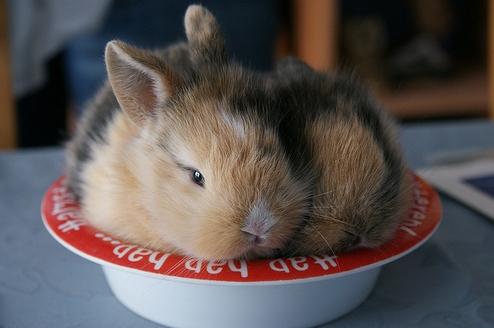
Q: What kind of litter should I use for my bunny’s litter pan?
A: Choosing the right litter is important. Bunnies will eat the litter out of the litter pan. Anything scented will make your bunny litter pan smell pretty but it could also make your bunny sick if ingested. If you choose to use litter intended for a cat, make sure you read the packaging carefully. Look for something that is natural. It’s also a good idea to avoid ceder or pine shaving as the strong scents are often believed to be bad for Bunny as well. Look for something that is made from recycled wood pulp or corn cob bedding. Both are great options. They don’t do much for odor control, but if you change bunny’s litter on a regular basis, you should be fine.

Q: How do I start litter training my bunny?
A: When it comes time to start litter training your rabbit, take note of where they normally relieve themselves. Most bunnies will have one spot in their cage where they like to go. Scoop the droppings out of that area and put the droppings in the litter pan. Since your bunny likes doing their business in that spot, that’s where you should put the pan. Generally speaking, older bunnies will get the hint pretty quickly. Younger bunnies may be a bit of a different story.
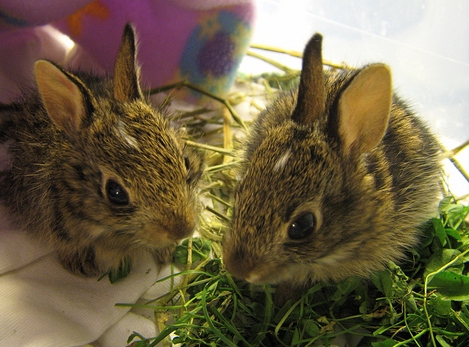
Q: How do I litter train younger bunnies?
A: Younger bunnies often lack the maturity to really understand what the litter pan is there for, so litter training takes a little longer. Since you should have already socialized your bunny and gotten them used to being held or picked up, pick them up when you see them using the bathroom outside of the litter pan and place them in the pan. Put any dropping you find as your bunny is having their out of cage time into the pan. They will understand in time and will start going into their pan on their own. When you notice this happening, use positive reinforcement like treats to reward them for their good behavior. Don’t punish them for using the bathroom outside of the pan, though. If they’re not using the pan as they’re supposed to be, it isn’t because they’re being naughty. It’s because they just don’t understand yet.
Younger bunnies also have a harder time controlling their bodies when it comes to relieving themselves. They often poop frequently as they run around and play. It might be a little undesirable, but speaking honestly, bunny poop isn’t really all that bad. If your bunny is healthy, the poop will be solid enough that you can just scoop it up without it staining the rug. Urine is a different story, but luckily, you’ll encounter bunny poop far more often than bunny pee.
That’s about it for this week. Next time we’ll talk about bunny grooming – why it’s important, what you need and how to do it – as well as how to teach your new bunny how to do a few simple tricks. Also keep an eye out for the guide to common bunny illnesses, the symptoms of those illnesses and how to prevent them – an important guide every bunny owner should see.











